We tested the Orbea Rise 2025 and it goes straight to our favorites
The Orbea Rise was one of the first lightweight eBikes to appear on the market and has been one of the most recommended since its introduction. It is a mountain bike with the best of both worlds and has just been updated to continue improving. Orbea invited us to the international presentation of this Rise 2025 and we were able to thoroughly test it on the demanding trails of Aínsa, one of the reference locations in Enduro.
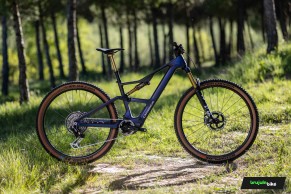
Orbea Rise 2025: the most capable lightweight eBike on the market
The path Orbea chooses for its flagship electric bike is quite ambitious. In the development of the Rise, they did not opt for the assembly of an ultralight motor and assume that a lightweight eBike has limited capacity. Orbea has chosen to have it all.
The main concept of the Rise is based on a collaboration between Orbea and Shimano to customize their EP801 motor by adding specific firmware to achieve the desired behavior for this bike. They did it in the previous Rise and developed the Shimano EP801-RS motor. A specific motor for this bike where a much more natural assistance was sought, limited to 54Nm, and battery optimization so that assistance is not a problem.
RECOMENDADO
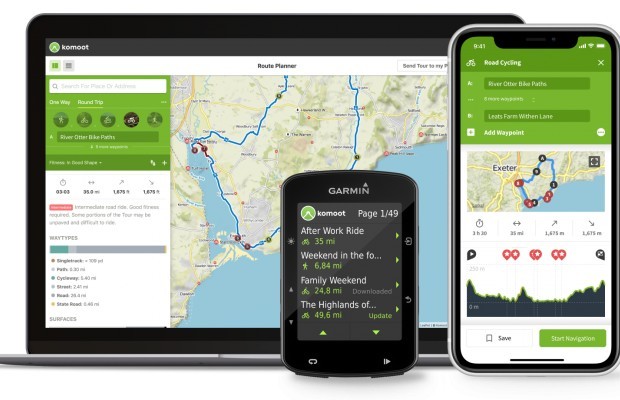
The best apps for cycling and mountain biking
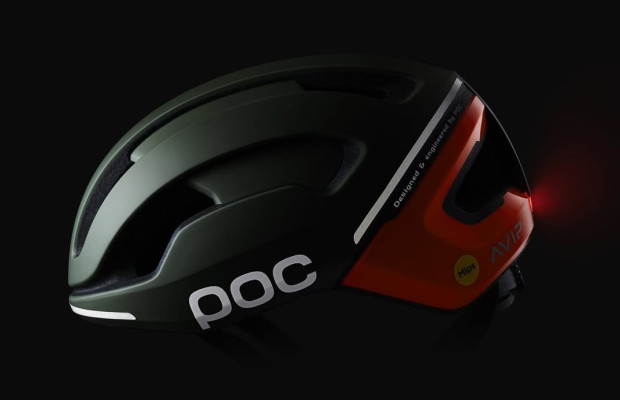
Black Friday 2025 cycling bargains: save on Garmin, POC, Maxxis and more
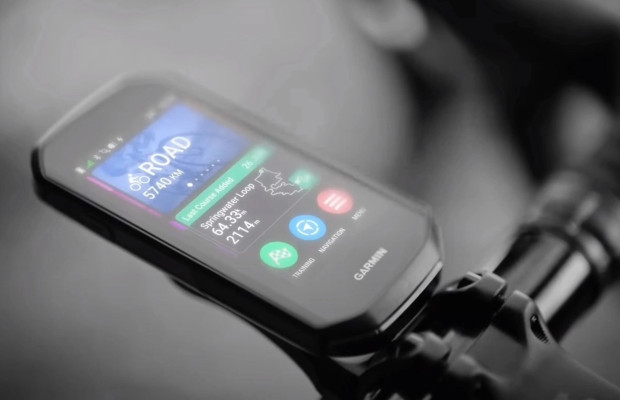
Black Friday Garmin 2025: the ultimate guide to choosing your GPS at the best price
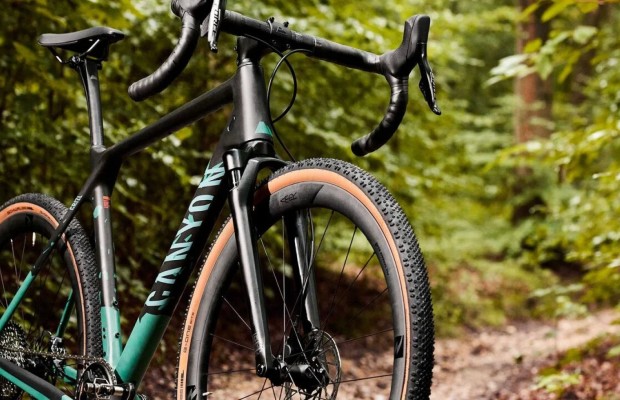
Do you need suspension on your gravel bike?
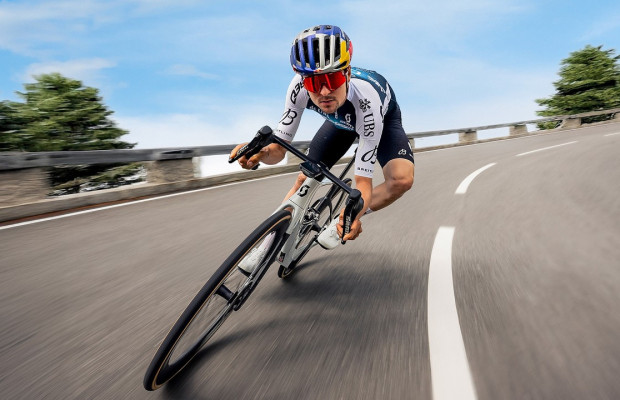
Countersteering, braking and cornering: the basics to improve your cornering skills
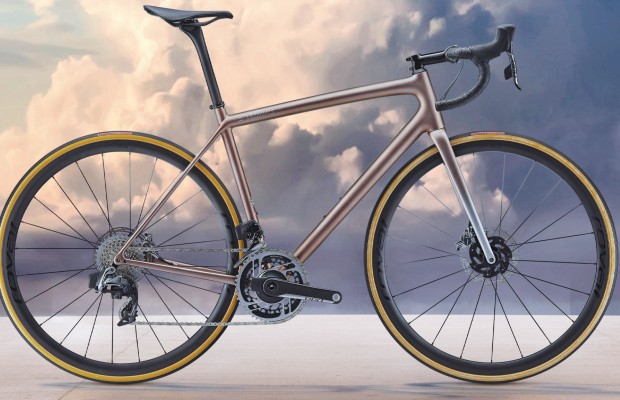
How to save weight on your road bike
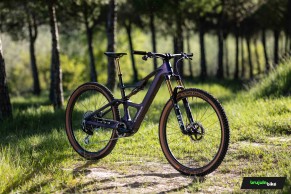
In this new version, they have taken it a step further and managed to improve the firmware to, with that same natural pedaling sensation, reach a maximum assistance of 85Nm.
The new motor is called EP801-RS GEN2 eMTB optimized, and has that same natural assistance and great battery optimization, as we have been able to verify and will tell you about below.
Now, in the Shimano eTube application, we can choose between two profiles before going out to ride. On the one hand, the RS profile, similar to the previous version of the Rise, and on the other hand, the RS+ profile, which is the great novelty of this system and will provide us with an extra assistance for those moments when we need to push hard, even at low cadences.
Both profiles will continue to be fully customizable according to our preferences.
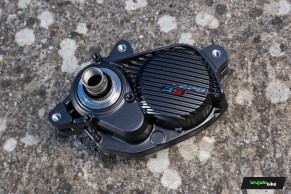
As we have already mentioned, the Shimano EP801-RS GEN2 motor optimizes battery consumption to the maximum, so a relatively small battery provides great autonomy. However, there are two battery sizes available for the new Rise, with more capacity than in the previous version, as the small one provides 420Wh and the large one 630Wh.
More than just an electric bike
What Orbea wanted to prioritize above all is the bike's performance on the terrain. For this, they have redesigned the frame and, among other things, have improved aspects such as rigidity, but where it is needed. They have taken into account the value of rigidity throughout the frame to achieve balance. The result is an 8% increase in rigidity in the front triangle compared to the previous Rise and a 14% improvement.
Also, the rigidity of each frame is optimized according to size, so that all users obtain similar sensations and response, regardless of their weight and size.
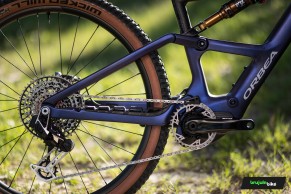
The new Rise adopts that asymmetric reinforcement arm that we already saw in the Occam and which, as they explained to us, has a significant impact on that rigidity tuning we mentioned earlier, at the cost of a mere 40g.
The suspension system is based on a single pivot with a pivot point concentric to the rear axle, providing greater sensitivity and independence from braking. In this version, the progressivity has been slightly increased to improve absorption capacity.
The total weight of the frame is 2.2kg in size M without shock absorber. Exactly the same weight as the previous version.
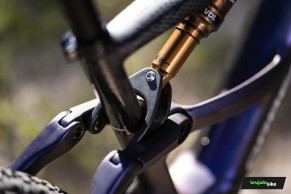
With the intention of optimizing the bike's handling as much as possible, they have gone a step further in the Steep and Deep concept, which is nothing more than maximizing the insertion of the seatpost to be able to mount seatposts with long travel in all sizes. This in an eBike is a challenge and they have had to redesign details such as the charging port or the main cable.
The result is a possible insertion of the seatpost up to a distance of just 110mm from the bottom bracket, which allows for mounting seatposts with really long travel.
SL and LT versions
Like the Occam model, the Rise range is divided into two versions. The Rise SL is focused on a slightly lighter Trail, with 140mm of travel on both wheels and taking into account weight a bit more in its assembly. The Rise LT version provides 160mm of front travel and 150mm at the rear, comes with forks with 36mm stanchions and a setup for a more aggressive use.
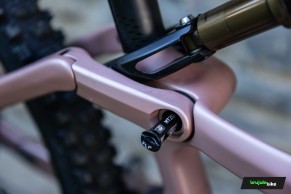
The frame is the same in both, except for the shock extender and the shock itself. In the SL, we have a carbon extender and in the LT, an aluminum one with a quick motion chip to change the geometry.
Orbea Rise 2025 LT M-TEAM
At the presentation that Orbea offered in Aínsa, we had contact with both versions of the new Rise, but the bike we had at our disposal to thoroughly test was the LT version, specifically the top-of-the-line M-TEAM.
This bike offers a rear travel of 150mm and 160mm at the front and a geometry that maximizes the capabilities of this bike thanks, among other things, to its instant geometry change chip through the integrated key in the rear axle lever. In a matter of seconds, we can slightly change the character of the Orbea Rise LT.

In the head angle we have a 64° or 64.5° depending on the chosen position. The seat tube angle also varies between 77° and 77.5°. The reach is 455mm in Low position and 460mm in High position and the bottom bracket drop varies between 26 and 34mm.
Orbea has made a great design effort to achieve the shortest possible chainstays and, with 440mm, they have managed to match the measurement of the Occam, which can be considered its non-electric sister, as practically all the geometry is identical in both bikes.
Regarding the assembly of this M-TEAM model, we have a Fox 36 Float Factory Kashima fork with the new Grip X cartridge. In the rear shock, we can choose a Fox DHX Factory coil shock or, like our test bike, a Fox Float X Factory. These types of choices, like much of the rest of the assembly, can be made thanks to the Orbea MyO program.
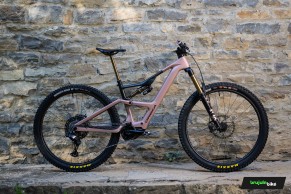
The transmission is entrusted to the Shimano XT Di2 group, which will give us an extra performance with its Free Shift system.
For brakes, we have the magnificent Shimano XTR 4-piston brakes.
As for the wheels, Oquo takes care of them, with the Mountain Control MC32LTD, with carbon rims and 32mm internal width, although also, thanks to the MyO program, we can opt for aluminum rims if we prefer.
The tires are Maxxis Assegai 2.5" wide in the front and Minion DHR2 2.4" wide in the rear. We can also choose between different more or less reinforced casings. Our test bike had an EXO+ casing in the front and a DoubleDown in the rear.
In the rest of the components, the OC brand predominates, highlighting a carbon MC10 handlebar in which we can also choose the desired rise between 20 or 35mm.
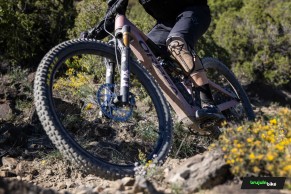
The seatpost on our bike was a Fox Transfer Factory Kashima with 200mm of travel for our size M, although we can also opt for an OC MC21.
The battery on our test unit was the 630Wh one, although it is the alternative option, as it initially comes with the 420Wh one.
The bike comes without a display, as with the Orbea App for GPS we can view motor and battery data on the same screen, and thus have a clutter-free cockpit, just like a non-electric bike. However, if preferred, a Shimano EN600 display is offered that attaches to the stem cap slot and integrates perfectly.
First impressions with the Rise LT
We had two intense days of testing, with double sessions each day, but we were left wanting more. During the first morning, we made our personal adjustments and from there, we enjoyed a truly spectacular bike on trails that had absolutely everything.
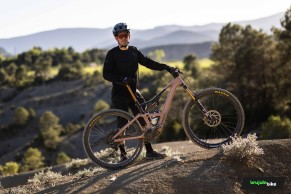
Our test bike, as we have advanced, was the Rise LT M-TEAM, but with some changes compared to the range mount, such as the choice of more reinforced rear tire or the 630Wh battery. We also used most of the time the air shock.
With this setup our bike yielded a scale weight of 19.68kg, which we thought was a great starting point, but when we were later able to check the actual capabilities of the Rise, we found the weight of the bike to be simply spectacular.
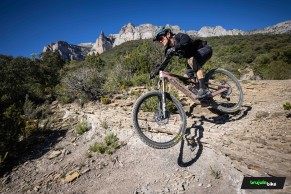
As we started the first route there wasn't much respite to get used to the controls and we soon found ourselves climbing quite technical terrain. The Orbea people were eager to show us the Rise's capabilities in this type of demanding terrain and the truth is that we were surprised from the first climb.
The Rise is not an eBike that will do everything for you. Those who want to climb with almost no effort and let the motor do all the work will have to look for another option, since the Rise is for the biker who enjoys all aspects of this sport and physical effort occupies an essential place in MTB. What the Orbea Rise does do is maximize the fun and make an impossible or extremely hard climb a challenge that we can face with an affordable level of effort.
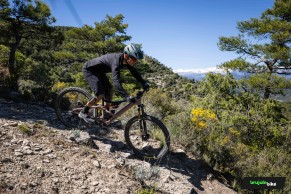
In the course of the first morning we faced more and more complicated climbs and we could see how the assistance of the Shimano EP-801 RS Gen2 motor is probably the most natural we have tested. There is no delay in the delivery of power and in hilly areas, where there are constant changes of momentum on the pedals, the motor adapts immediately to what we do with our own pedaling, offering us a sensitivity to the traction of the rear wheel that allows us to adapt perfectly to what the terrain demands and overcome the most difficult challenges with a sufficiency that left us quite surprised.
With the new RS+ setting profile, the motor gives us up to 85Nm, and the truth is that we were able to put it to the test as we found ourselves, during the days we enjoyed the Rise, with some really challenging ramps and we were able to climb them, sometimes even surprising ourselves, since the power of the motor goes together with that "feel" that we mentioned before and allows us to maximize traction to not lose momentum in the most compromised areas.
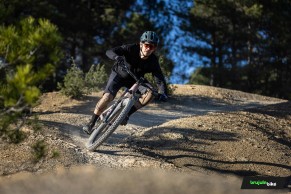
When it was time to go downhill the Rise began to show us all its virtues. It is to be expected that a bike with Fox's best suspension for aggressive Trail or Enduro and such an updated geometry would perform well on descents, but the Rise LT offers truly remarkable behavior. In addition to the aforementioned, the weight is very low for an electric bike and is concentrated in the lower part of the bike, giving the Rise great stability.
But once we got into it, descending at speed on rough trails and constantly improvising, since it was the first time we were descending every trail in the area, the Rise LT offered us great control and confidence. The balance achieved in the overall stiffness of the bike has a lot to do with this.
The Orbea Rise LT provides us with alternative advantages
In addition to the great capabilities of the Rise LT there are some details that make even more of a difference.
One of these details is a geometry change chip with the fastest and easiest operation we have tested. This type of solution is becoming more and more common, but it is usually necessary to remove a bolt completely and even release one of the shock anchors. On the Orbea Rise LT, all you have to do is slightly loosen the shock mount with the extender, and the chip will rotate on its own as you lift or release the bike. We fix it again and that's it. It can also be done with the key that is integrated in the rear axle lever, so the process only takes a few seconds.
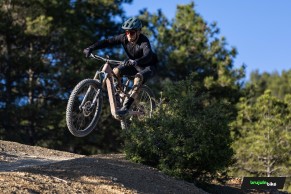
The fact that it's so easy makes it something we're going to use quite often, as it's worth tackling those technical climbs with a slightly higher bottom bracket and a little more sparkle in the bike's movements. And on the descents we have the poise and stability of a very downhill geometry.
The truth is that we use it quite a lot and we clearly notice the change in behavior, which is a real plus for the Rise LT.2.
And continuing with certain details that make things easier for us or, directly, can make us faster, we have to talk about the Free Shift technology of the Shimano XT Di2 drivetrain. Thanks to this we can shift gears on downhills without pedaling. This allows us to anticipate that pedaling zone that we may encounter in the middle of a descent without having to lose our control position during the descent. Whether it's a sudden climb or a flat where we can push, we can always have the right gear engaged.
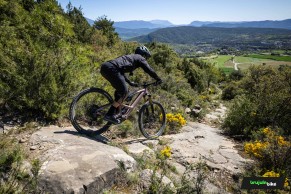
It is true that it requires practice and to automate certain new gestures, but at the end of our tests with the Rise we were already taking advantage of this help, so with time we have no doubt that it can become almost essential for those who have tried it.
With the Orbea Rise 2025, range is no longer a concern
With Orbea's RS Gen2 firmware battery management, you don't need a high-capacity battery to have a lot of autonomy.
Thanks to the Orbea App for our Garmin, in addition to having the motor and battery data on the screen, we were able to review the route data on Garmin Connect and see all the parameters.
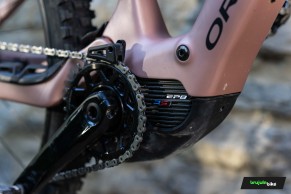
In our case, with 75 kilos, and because of the really rough terrain they had prepared for us and, in addition, almost constantly abusing the maximum assistance mode, since the pace we were carrying was very high, the data were these:
The first day we rode 39km with 1400m of positive slope and used 73% of the battery. The second day 42km and 1150m of elevation gain and we used 69%.
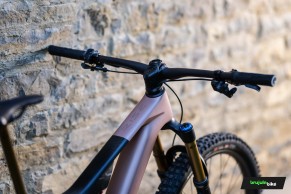
As mentioned above, our bike was equipped with a 630Wh battery, but given this data we could have gone with a 420Wh battery.
Final conclusions
It has been two intense days with double sessions each one of them, but we have been left wanting more. During the first morning we made our personal adjustments and from there, we enjoyed a really spectacular bike on trails that had absolutely everything.
The Orbea Rise is an electric bike that does not "contaminate" the authentic sensations offered by an MTB. A natural pedaling with a plus of energy that allows us to extend in an epic way our fun days and, at the same time, capabilities and handling that make us face the most aggressive descents with the confidence of knowing that the limit of the Rise is far enough away.
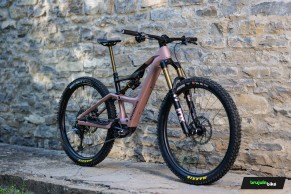
Orbea Rise 2025 LT M-TEAM: specifications and price
- Frame: Orbea Rise OMR 2025, 150mm
- Fork: Fox 36 Float Factory Kashima 160mm, GripX
- Shock: Fox DHX Factory 2-Pos 210x55 (opyions in MyO)
- Crankset: Shimano Steps EM900
- Handlebar: OC Mountain Control MC10 Carbon, rise 20 (rise 35 in MyO)
- Stem: OC Mountain Control MC11 All SL
- Shifter: Shimano M8150
- Rear derailleur: Shimano XT Di2 M8150 12s
- Chain: Shimano CN-9100
- Brakes: Shimano XTR M9120
- Wheels: Oquo Mountain Control MC32LTD (MC32TEAM in MyO)
- Cassette: Shimano XTR M9100 10-51
- Front tire: Maxxis Assegai 2,50” EXO+ / TR MaxxGrip (options in MyO)
- Rear tire: Maxxis Minion DHR2 2.40” EXO+ / 3C MaxxTerra (options in MyO)
- Seatpost: Fox Transfer Factory Kashima 31,6 (options in MyO)
- Saddle: Fizik Terra Ridon X1
- Motor: Shimano EP801-RS GEN2 eMTB optimized
- Battery: Orbea Internal 420Wh (630Wh option in MyO)
- Price: 10,999€